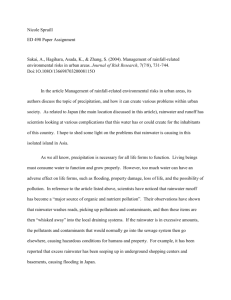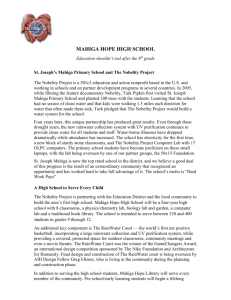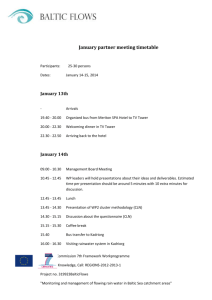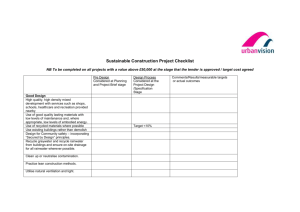POLLUTION SECTION 9-IMPURITIES IN RAIN OBJECTIVES MATERIALS
advertisement
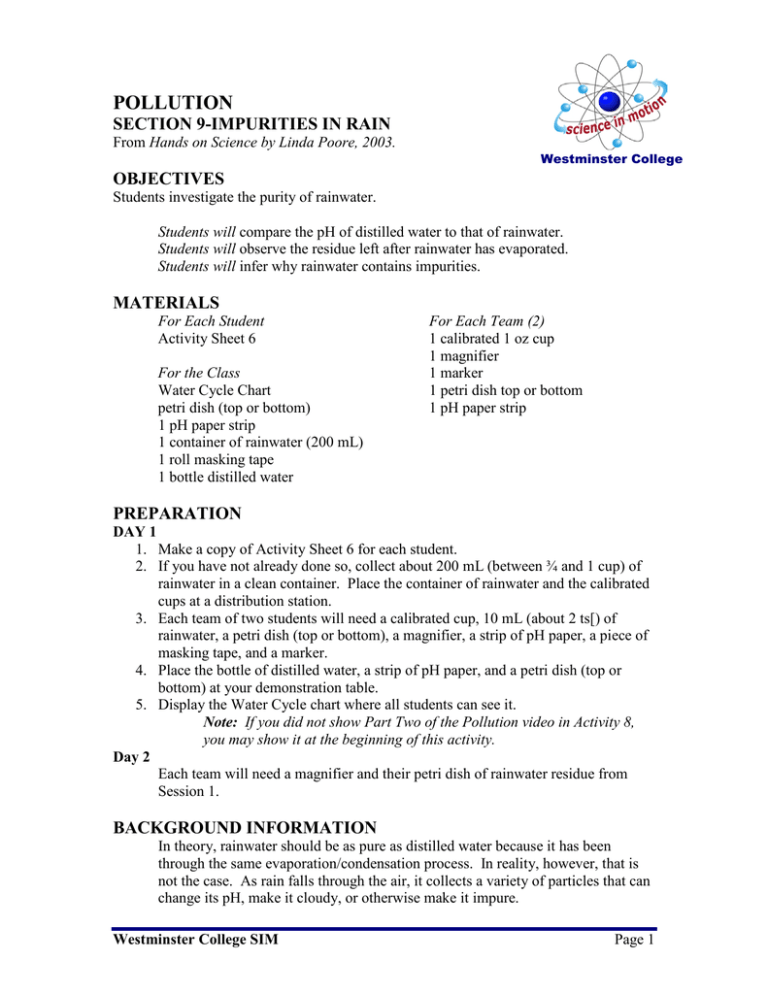
POLLUTION SECTION 9-IMPURITIES IN RAIN From Hands on Science by Linda Poore, 2003. Westminster College OBJECTIVES Students investigate the purity of rainwater. Students will compare the pH of distilled water to that of rainwater. Students will observe the residue left after rainwater has evaporated. Students will infer why rainwater contains impurities. MATERIALS For Each Student Activity Sheet 6 For the Class Water Cycle Chart petri dish (top or bottom) 1 pH paper strip 1 container of rainwater (200 mL) 1 roll masking tape 1 bottle distilled water For Each Team (2) 1 calibrated 1 oz cup 1 magnifier 1 marker 1 petri dish top or bottom 1 pH paper strip PREPARATION DAY 1 1. Make a copy of Activity Sheet 6 for each student. 2. If you have not already done so, collect about 200 mL (between ¾ and 1 cup) of rainwater in a clean container. Place the container of rainwater and the calibrated cups at a distribution station. 3. Each team of two students will need a calibrated cup, 10 mL (about 2 ts[) of rainwater, a petri dish (top or bottom), a magnifier, a strip of pH paper, a piece of masking tape, and a marker. 4. Place the bottle of distilled water, a strip of pH paper, and a petri dish (top or bottom) at your demonstration table. 5. Display the Water Cycle chart where all students can see it. Note: If you did not show Part Two of the Pollution video in Activity 8, you may show it at the beginning of this activity. Day 2 Each team will need a magnifier and their petri dish of rainwater residue from Session 1. BACKGROUND INFORMATION In theory, rainwater should be as pure as distilled water because it has been through the same evaporation/condensation process. In reality, however, that is not the case. As rain falls through the air, it collects a variety of particles that can change its pH, make it cloudy, or otherwise make it impure. Westminster College SIM Page 1 IMPURITIES IN RAIN A natural chemical reaction with carbon dioxide in the air turns neutral rainwater slightly acidic (pH 5.6). Rainwater that has a pH of less than 5.6 is called acid rain. Acid rain forms when moisture in the air combines with the nitrogen oxides or sulfur dioxides released when fossil fuels (coal, gas and oil) are burned. The resultant acidity of the rain can be quite strong, sometimes registering as low as 2.0 on the pH scale. In addition to acidic gases, rainwater can contain a variety of other impurities, such as grit, dust, and other gases. GUIDING THE ACTIVITY DAY 1 1. Invite a student to come up to the demonstration table and measure the pH of distilled water using a strip of pH paper. The distilled water should be neutral or almost neutral. Then ask, How clean do you think rainwater is when it reaches Earth’s surface? Students will probably respond that rainwater, because it has evaporated and condensed, is as pure as distilled water. Direct their attention the Water Cycle chart and review the process with them. Tell them that they will test the rainwater that fell near their school to see just how pure it is. As needed, remind students that the water cycle is the ongoing movement of water between Earth and the atmosphere through evaporation, condensation, and precipitation. 2. Divide the class into teams of two and invite a member from each team to come up to the distribution station and pout about 10 mL (about 2 tsp) or rainwater into a calibrated cup. Meanwhile, distribute a copy of Activity Sheet 6 to each student and a strip of pH paper, a magnifier, a petri dish (top or bottom), a piece of masking tape, and a marker to each team. 3. Tell the teams to observe the rainwater and to test its pH. Then ask,What does the rainwater look like? Does it have an odor? What is the pH of the rainwater? Can you see any impurities in the rainwater? Have students record their observations on Activity Sheet 6. Rainwater is usually clear or almost clear; it may have a very slight odor. Most of the time it is slightly acidic. It is doubtful that students will notice impurities, even with a magnifier. Westminster College SIM Page 2 IMPURITIES IN RAIN 4. Tell the teams to use masking tape and the marker to label their petri dishes. Then have them pour the rainwater into the dishes and place them, uncovered, near a window. In an uncovered dish, the rainwater should evaporate in three to seven days. 5. Have a student volunteer pour 10 mL of distilled water into a petri dish. Use a piece of masking tape to label the dish Distilled Water and place it, uncovered, near the rainwater dishes. Ask, Why have I placed a dish of distilled water among the dishes of rainwater? Students should realize that the dish of distilled water is the control. If necessary, point out that as the dishes of rainwater sit uncovered for several days, inevitably particles from the air will fall into them, adding to the residue left behind after the rainwater has evaporated. By setting out an uncovered dish of distilled water, students will be able to compare any residue found in the rainwater dishes with the residue found in the distilled water dish. 6. Dispose of the used strips of pH paper and any leftover rainwater. Rinse and air dry the rainwater container and calibrated cups and return them, along with the magnifiers, to the kit. Westminster College SIM Page 3 IMPURITIES IN RAIN Westminster College SIM Page 4 IMPURITIES IN RAIN Day 2 7. When all of the rainwater in the petri dishes has evaporated, redistribute the magnifiers to the teams and have them look for any signs of rainwater residue. For comparison, pass around the control-the dish of residue from the distilled water. Then ask, What did you find in your petri dishes after the rainwater had evaporated? What did you find in the dish after the distilled water had evaporated? Students may see some grit, dust particles, or fine dust int eh rainwater dishes. The control may contain a few dust particles that settled over the course of the week, but not nearly the amount of residue that was found in the rainwater dishes. Ask¸ Where do you think the residue in the rainwater dishes came from? Most students will understand that the residue they see in their dishes was suspended in the rainwater before the rainwater evaporated. Ask, Where do you think the impurities in the rainwater came from? The impurities were picked up by the rain as it fell to Earth. These impurities may come from a variety of sources, including factories, farms, and even forest fires or volcanoes. 8. Ask, Was the pH of your rainwater neutral? If the students’ samples were slightly acidic, be sure to remind them that rainwater may be slightly acidic naturally. 9. Write the term acid rain on the board. Explain the acid rain forms when moisture in the air combines with gases and particles in the air. The resulting rainfall has a greater than normal amount of acid in it and therefore has a pH of less than 5.6. Explain that acid rain can harm living organisms as well as corrode buildings, statues, cars, and other objects that are exposes to it. Ask, What do you think is the source of acidity in rainwater? Students may know that most of the acidic gases and particles come from the nitrogen oxides and sulfur dioxides released when fossil fuels (coal, oil, and gas) and burned. These gases/particles could be local in origin, or they could have been carried a considerable distance by the wind. Have students complete Activity Sheet 6. Westminster College SIM Page 5
